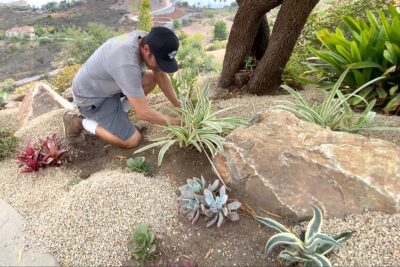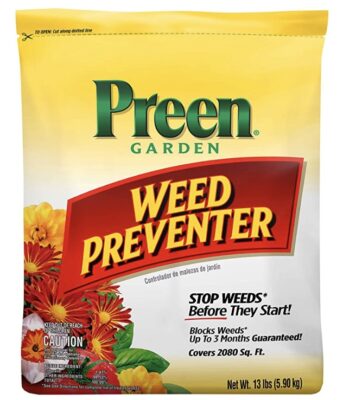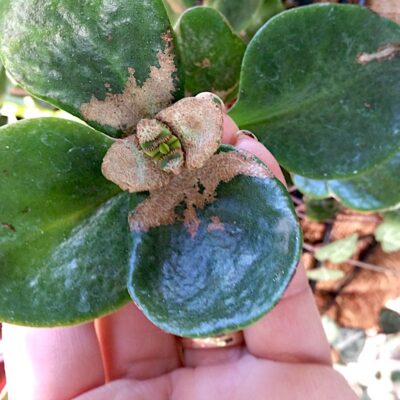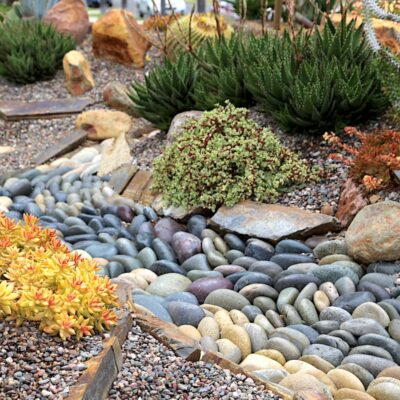
Should You Use Weed Barrier Fabric?
No doubt you've seen black fabric laid over bare soil with holes cut out for plants. It's meant to stop weeds from coming up. How important is such "weed barrier fabric?" What are the do's and don'ts? Find out in this recent exchange in my Pests and Problems Forum. And if you have experience with the product yourself, do let us know!
Weed Fabric? "Huge fan!"
Reader comment: "I am a huge fan of landscaping fabric for weed control. I have never noticed any adverse effect on the health of my succulents. In fact, the succulents in the area I covered with landscaping fabric (and rock cover) look better than those planted in soil with only rock cover. I suspect this is due to better water retention in the fabric-covered soil. And saving irrigation water is crucial in California these days, as always."
DLB: "Not in MY Yard!"
My response: I know professional landscape designers who use weed barrier fabric routinely, others who don’t like it, and others who use it only in specific circumstances. Here’s my take on it.
The previous owners of my home (where I’ve lived 30+ years) installed weed fabric beneath gravel pathways and in some planting beds. Where the fabric has seams, it pokes up through the soil and looks messy. Burying exposed edges doesn’t help—dirt just slides off—so I take a sharp knife and slice the fabric back as far as I can. Even then, gravel or soil gets under it, causing it to lift again. Aargh.

Weed fabric fail: Despite being buried, it still comes up.
When I looked at the ground underneath, it’s hard-packed and dry---not an environment conducive to earthworms and other beneficials that need a friable, oxygen-rich environment.
I’ve seen weed cloth in friends’ gardens installed on slopes…oh, don’t get me started! The topdressing—whether bark, mulch or crushed rock—eventually slides off from its weight and gravity. Double aargh!
As for holding moisture in the soil, keep in mind that barriers work both ways. Rain and irrigation need to percolate downward, and a barrier fabric diminishes its ability to do so. Moreover, healthy soil needs to breathe.
What I recommend
Hence my preference for using crushed rock topdressings, solely, to cover bare dirt. They stay in place, reduce evaporation, discourage seeds from sprouting, make weeding easy (if seeds do sprout), and lend an aesthetically pleasing finishing touch. Not to mention they're less work. Installing black fabric—although I’ve not done it myself—looks like a pain.
How to prevent weeds?
I try to avoid putting chemicals on my garden, and I won't use Round-Up, so I'm glad there's a less controversial option: pre-emergent herbicide. It’s a powder that stops weed seeds from germinating. It needs to be applied in fall or winter, ideally before the first rainstorm. One brand is Preen. (Affiliate link.)
After adding crushed rock topdressing to a newly planted area, I sprinkle it with "weed preventer" powder. Watch landscape designer Steve McDearmon do this at 5:05 of my video: “See a Succulent Collector’s Garden Redo." Btw, in the video, Steve also talks about weed barrier fabric.
Every spring, thanks to applying pre-emergent herbicide in winter, I have fewer weeds than the previous spring. In March and April, my gardener spends about an hour weeding my half-acre’s exposed, sunny areas. However, next door—for that matter nearly every yard in my ‘hood—it's a different matter: Weed removal requires a day or more of unpleasant labor and hauling away, after which nothing is done to keep weeds from coming back. Triple aargh!
So, what say you? Tell us in the comments below!
Related Info on this site
Succulent Pests and Problems Q&A Forum
Are pests or mysterious maladies causing problems with your succulents? This page is a forum for you to ask questions, leave comments and share what works for you. Others can see and benefit from the answers. Your own tried-and-true solutions are welcome, too!
Succulent Landscapes
Succulent Landscapes Design ideas and must-dos for your yard’s transformation Want to transform your yard into a low-maintenance, low-water succulent garden? This page guides you to helpful info on this site and on my YouTube channel. Before you purchase plants or pick up a shovel, do obtain my book Designing with Succulents (2nd ed). It’s mainly about…





I love the idea of using rock mulch – my favorite is lava rock, which succulents love. In some areas, two or three layers of newspaper or newsprint goes on first, then the rock on top. Eventually, the newspaper rots away, the lava rock is incorporated into the soil to make it even better for the plants, and another layer goes on top.
Debra-
One of my favorite garden tools is a weed flamer. I bought it from Amazon, can’t remember the price, but it wasn’t expensive. It uses a small canister of propane, has an easy on/off mechanism, and has an easy-to-use handle – looks a bit like a aluminum cane.
It is great for the few weeds that come up between my succulents, on a long mound with only rocks over the soil. I also use it for small weeds that come up between pavers or the edge of a patio and a cement block wall or between sidewalk and curb.
Check it out. It is a wonderful tool for SMALL weeds.
I have two thirds of an acre. Here since 1988. Eighty per cent succulents. I do my own weeding. In my garden I find that a rock ground cover, with or without gardeners cloth, is not conducive to caring for my plants. I use walk on bark. Not as pretty as rocks but much easier to work with. When replacing a plant or moving it or breaking it up to make other plants, I find walk on bark a better soil amendment. Plus when I am finish, I can handle a bag of bark easier than having, small rock or DG. I weed by walking my garden at least once every two weeks (I do have a gardener who comes twice a month to do light gardening but to mostly blow the garden for leaves and debris).
I totally agree with you about the problems with landscape fabric. At the very best it might give someone a year or two of weed control. I do, however, disagree about the use of pre-emergent herbicides. I have VERY few weeks in my very large garden because everything is mulched either with rock or bark or shredded fir. The few weeds that show up occasionally are easy to jerk out and I would say I probably spend about two hours a YEAR pulling weeds, mostly 30 seconds at a time!
Excellent comments from all, thank you! I have used all of the methods mentioned here–landscape fabric, Preen pre-emergent, rock cover in 1 inch and 1 1/2 inch sizes, and propane torch. I’ve found the propane torch most useful in controlling the weed spotted spurge (Euphorbia maculata). Of course I use it only in areas with rock cover only and with no landscape fabric. I suspect one of the main benefits of applying oxidizing levels of heat to an area is that it kills the abundant seeds that spread locally, as well as the parent plant.
Of course it’s mandatory to be mindful of wind conditions, any plant fuel in the area you’re treating, and to have a garden hose ready when using a propane torch. I always thoroughly douse the area with water after treating, to quench any smoldering plant matter or embers.
In my previous yard an area was covered with little stones over a weed barrier done by earlier owner. Was very difficult to pull weeds with the roots. Each year the weeds came back bigger with revenge. Was also almost impossible to dig or plant anything with all those little rocks. Will never use little rocks as weed barrier again. Mulch works best and also decomposes into the soil.
After fabric has been down awhile soil drifts and settles in ON TOP of the weed fabric and then the weeds settle in also. I have been a professional landscape designer for 30 years. I never ever recommend using weed fabric!
I am going with landscape fabric for now. I know the drawbacks and love the idea of crushed rock, but for now the fabric is lighter weight and gives some flexibility (easier for me at least) for future changes.
Hello Debra…I’m with you ! I can’t stand the stuff…16yrs ago our gardens were covered in that black fabric…what did we know ! We’re from NE and we certainly don’t use or had even heard of fabric cloth…so down it went and we have been slicing it up and tearing it out since. Top dressings, whether mulch or rock, slide of of it making our lives all that much more frustrating. And so over the years most of it is gone which required alot of hard work to accomplish. Oh, and since you’ve opened a bucket of worms…we’ve ripped up all of that awful black plastic edging. This stuff was included in our landscape package…more money for them…lots of unnecessary work for us ! Thats how dumb gardeners from NE became familiar with the ways of the South.
Have a wonderful weekend, Debra…Judith and Keith
I have been hired for large weed removal projects. We have had to remove the fabric so that we were able to remove the weeds.
My big problem with landscape fabric is that the worst weeds grow through it. The fabric makes it impossible to dig the weed out and when you pull them out, the roots remain under the fabric. The only solution is to use a product such as glysophate that enters through the leaf and kills the roots. Many clients object to this.
In addition, I have had all of the problems in the comments and consider it a waste of client’s money.
Hi Tina — Good to know. “A waste of client’s money” is pretty convincing. Thanks!
Thank you for this informational blog. I hope it could help a lot of gardeners out there who are planting succulents.
Much appreciated, coming from a landscape professional! Thank you for commenting.
After buying a few succulents on line this year, I noticed a white powder substance on quite a few of the plants. It had spread to most of my plants that I had in my greenhouse. After sending you an e-mail and telling you that I thought I had white flies, you mentioned it was probably mealy bugs. Well, I had been using every insect spray I could think of and nothing was working. It was just getting worse. I asked what you thought of alcohol and you said that would probably work. Well, work it did! I have been spraying with alcohol and I think I have it under control. I thank you for all your communication and the help with this pest problem. Never again will I buy plants online unless it is a reputable business. My plants are finally happy again and pest free.
Hi Bobbie — I’m so glad you found an answer that helped! Thanks for leaving a comment.
I see most commenters have sen the lght.
As a landscape architect and longtime gardener in Florida I have experienced landscape fabric/weed barrier on dozens of properties. It is another petroleum-based product that was created for corporations to make a profit even though there was no need for it and it does not work as advertised. It is mostly useless, increases labor, adds cost, and is even harmful in the garden as it slows rainwater percolation.
Organic matter happens! That is why there is archaeology. As dirt/soil/organic matter builds up on top of landscape fabric it provides the organic matter that weed seeds need to sprout – they also need sunlight and moisture.
As others have mentioned, weeds then root into the fabric making removal more difficult.
Want to add more plants? Then have fun slicing the fabric or trying to remove some of it which may be rooted in.
The ONLY time it may be useful is where loose stone is used as a mulch. It will keep the stone from sinking into the soil. However, it will still fill with organic matter. So then, vacuum the rocks or remove them, clean the area and stones, and replace them.
Please don’t put garbage in your garden and waste petroleum, a finite resource. Be sustainable!
I see most commenters have seen the light.
As a landscape architect and longtime gardener in Florida I have experienced landscape fabric/weed barrier on dozens of properties. It is another petroleum-based product that was created for corporations to make a profit even though there was no need for it and it does not work as advertised. It is mostly useless, increases labor, adds cost, and is even harmful in the garden as it slows rainwater percolation.
Organic matter happens! That is why there is archaeology. As dirt/soil/organic matter builds up on top of landscape fabric it provides the organic matter that weed seeds need to sprout – they also need sunlight and moisture.
As others have mentioned, weeds then root into the fabric making removal more difficult.
Want to add more plants? Then have fun slicing the fabric or trying to remove some of it which may be rooted in.
The ONLY time it may be useful is where loose stone is used as a mulch. It will keep the stone from sinking into the soil. However, it will still fill with organic matter. So then, vacuum the rocks or remove them, clean the area and stones, and replace them.
Please don’t put garbage in your garden and waste petroleum, a finite resource. Be sustainable!